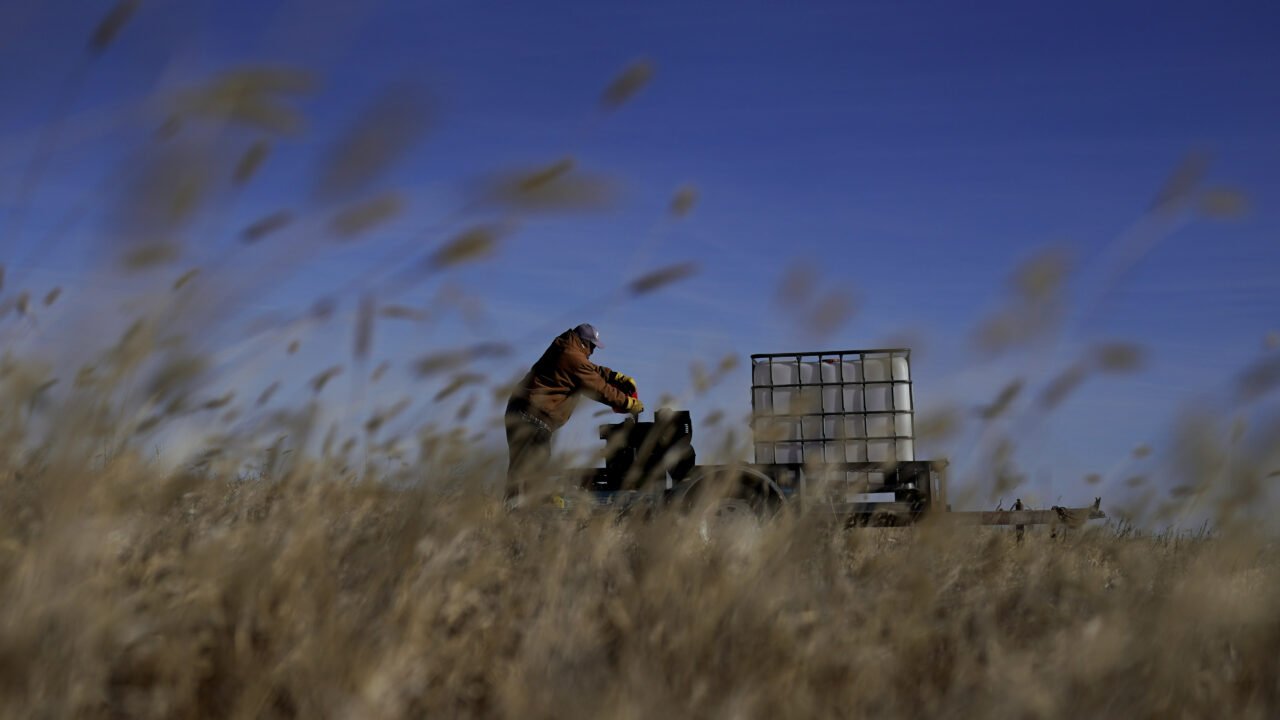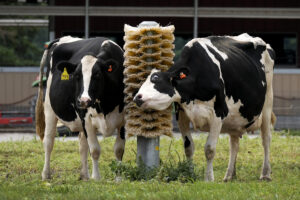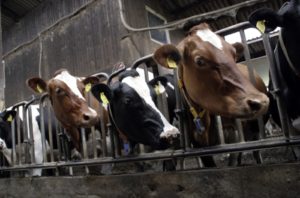Farmers Face Frozen Jobs and Heavier Workloads Under DOGE ‘Efficiency’ Budget
Billions in halted or canceled grants, gutted local offices, market turmoil and broken trust are at stake across the West. Rod Bradshaw tries to start an air compressor as he does chores on his farm near Jetmore, Kan., in 2021. (AP Photo/Charlie Riedel)
Rod Bradshaw tries to start an air compressor as he does chores on his farm near Jetmore, Kan., in 2021. (AP Photo/Charlie Riedel)
This story was originally published by High Country News.
Anna Jones-Crabtree and her husband spend sunup to sundown — plus hours of time before and after — nurturing 20 crops through tight margins on their dryland organic farm in Montana. Federal grants have long helped ease those tight margins, enabling farmers like Jones-Crabtree to survive and even thrive despite droughts and fires, market swings and crop failures. It’s the fruit of a philosophy that stewarding large tracts of land benefits not just a country with 340 million hungry bellies and a global food economy but also the clean air and water that people depend on as well as the land wildlife needs to survive.
So she was taken aback when the U.S. government froze half of a $100,000 grant the farm had received to hire people for regenerative agriculture work. She had workers and a crop plan ready, but now it looked like the rest of that money would never be paid out.
Other Department of Agriculture money still seemed to be coming through, but she was counting on that $50,000, just like thousands of other farmers and ranchers across the West have been counting on the billions promised through various programs from the U.S. Department of Agriculture. But now the Trump administration is trying to end many of these grants using a tool supposedly designed for efficiency that has also caused unpleasant side effects and cost thousands of American jobs.
“We’re in a tight spot. Combine that with the markets right now,” she said, “and this is unprecedented. It’s a perfect storm.”
The damage done to farmers and ranchers by grants frozen or ended by the Department of Government Efficiency is compounded by the loss of local staff at the Natural Resources Conservation Service and Farm Services Administration (FSA) offices that have traditionally provided on-the-ground support for projects. In fact, the USDA announced Monday that it plans to cancel its grants for the Partnerships for Climate-Smart Commodities, though it may approve some of them if they meet the administration’s priorities.
“This is unprecedented. It’s a perfect storm.”
More than 5,700 probationary employees at the USDA were fired in February, according to Mary Pletcher Rice, an acting deputy assistant secretary that oversees human resources at the agency. And while Rice testified that they were reinstated following a court order in March, many of the workers say that they’re still on administrative leave or have taken early retirement or buyouts, while others are anticipating further dramatic reductions in force. One FSA office in Montana, where rancher Bill Milton lives, went from five staff to one. Other offices around the rural West shuttered completely. The changes are creating a “disturbing amount of uncertainty,” Milton said. The office helps Montana landowners identify grants and file critical paperwork so money funnels into on-the-ground projects. Without enough employees around, deadlines are missed, and farmers are left hung out to dry.
Milton runs a 15,000-acre ranch in rural Musselshell County. He also works with community-based landowner groups seeking solutions to common problems — helping young ranchers access land as well as building sustainable ranches and solving watershed issues. Some groups in Montana have had grants of up to $4 million frozen.
“The squeaky wheel gets the grease, so people are putting pressure on their congressmen to release signed grants,” he said. “But everyone has staff. And as soon as grants get frozen, they have cash-flow issues.”
He and other Western producers acknowledge that there are certainly ways to make the government more efficient. But there is nothing particularly efficient about withholding money needed for repairing fences, hiring agricultural workers or building drought resilience in farms across the Western United States.
“You’re cutting things on the wrong end here,” said Traci Bruckner, chief policy officer for the Western Landowners Alliance. Federally supported local partnerships are, she said, “how you do conservation right — from the ground up.”
And the need is as great now as it’s ever been, said Robert Bonnie, former undersecretary of Agriculture for farm production and conservation under President Joe Biden. When Congress passed the Inflation Reduction Act, it committed nearly $20 billion to agriculture and forestry. While the branding dubbed it “climate smart agriculture,” most of the programs involved things that farmers, ranchers and foresters had been doing for decades through the Farm Bill.
“It’s soil health, improving grazing management, improved forest management to reduce nitrogen,” Bonnie said. “It’s reducing chances of catastrophic wildfires. And there’s a huge demand for it.”
“You’re cutting things on the wrong end here.”
Applications poured in from farmers, ranchers and working groups — so many, in fact, that within the first three years the federal government had committed all of the IRA money. But billions have yet to be paid. Utah farmers, for instance, are still owed $210 million between now and 2031, according to the University of Illinois’ Policy Design Lab. Washington is supposed to receive about $304 million, while Montana was set to see even more come through in the form of programs like the Environmental Quality Incentives and Conservation Stewardship.
In addition to local grants to improve fencing or build pivots, those dollars were also headed to programs such as the USDA Migratory Big Game Initiative, which has supported private-land restoration and paid for easements to keep such land intact for wildlife, including elk, deer and pronghorn.
Federally supported local programs may have seemed like a given, but landowners haven’t always trusted the federal government to follow through on its promises, said Maggie Hanna, a Colorado Springs, Colorado, rancher and director of the Central Grasslands Roadmap Initiative, a 700-million-acre collaborative working on grasslands conservation. And that’s why she’s even more concerned.
“To have a producer say, ‘I would like you, the federal government, to come to the table to be my partner’ is a big deal, and we’ve spent 40 years building that trust,” Hanna said. “And whether or not dollars come out of that scenario now, that trust feels deeply and dramatically eroded.”
She’s a farmer, though, and an eternal optimist. And so she wonders if perhaps pulling the rug out from under producers could ultimately help farmers and ranchers coalesce more and work together, teaching each other how to build fences or use rotational grazing. She doesn’t want to sound “Pollyanna-ish,” she said, but the possibility serves as a light for her in a West darkened by uncertainty.
Meanwhile, calves are being born and seeds being planted even as producers from New Mexico to Washington struggle with the fallout from the economic losses and uncertainty caused by President Donald Trump’s new tariffs.
“There’s a lot of fear and a lot of stress. Ranching and farming are difficult even when farming is going well,” Milton said. “But the most important point I’m making to people and each other is don’t just wait and see what the hell will happen. Let’s let those who are in rural communities keep doing good, collaborative work. The last thing you want to do is shut that down.”
Dig, Root, GrowThis year, we’re all on shaky ground, and the need for independent journalism has never been greater. A new administration is openly attacking free press — and the stakes couldn’t be higher.
Your support is more than a donation. It helps us dig deeper into hidden truths, root out corruption and misinformation, and grow an informed, resilient community.
Independent journalism like Truthdig doesn't just report the news — it helps cultivate a better future.
Your tax-deductible gift powers fearless reporting and uncompromising analysis. Together, we can protect democracy and expose the stories that must be told.
This spring, stand with our journalists.
Dig. Root. Grow. Cultivate a better future.
Donate today.





You need to be a supporter to comment.
There are currently no responses to this article.
Be the first to respond.